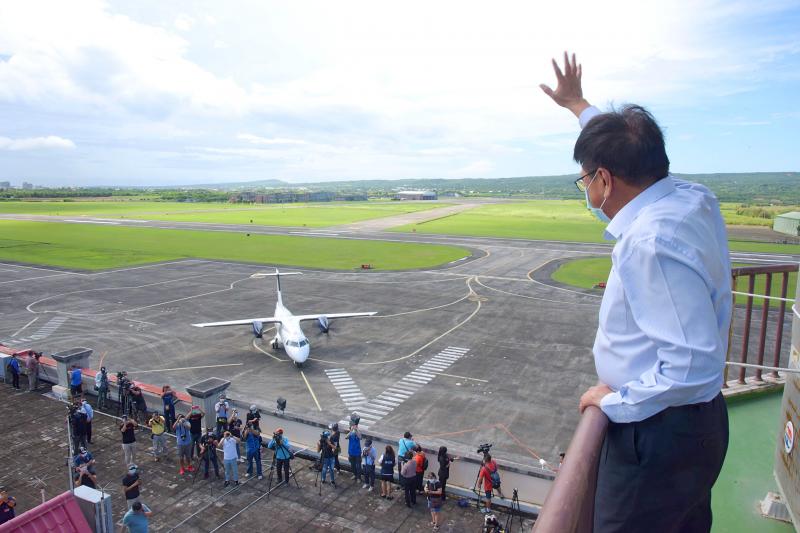Starting today, Chinese spouses who hold a reunion permit can apply to enter Taiwan and travelers without symptoms from the Philippines do not need to be tested for COVID-19 upon arrival, but are to be tested after a 14-day quarantine, the Central Epidemic Command Center (CECC) said yesterday.
Minister of Health and Welfare Chen Shih-chung (陳時中), who heads the center, said that from today, Chinese who are married to a Taiwanese citizen and hold a reunion permit can apply to the National Immigration Agency for entry into Taiwan.
Chinese who are married to a foreign national and hold an accompanied reunion permit and their minor children can also apply, but all travelers that arrive in Taiwan would need to undergo a 14-day home quarantine, he said.

Photo courtesy of Pingtung County Government via CNA
Deputy Minister of the Interior Chen Tsung-yen (陳宗彥), who is deputy head of the center, said that 740 people are eligible to apply: 666 Chinese spouses that hold a reunion permit and 74 Chinese spouses that hold an accompanied reunion permit.
Since July 26, all arrivals from the Philippines have been tested for COVID-19 at the airport, Chen Shih-chung said.
Of the 1,238 arrivals tested as of Sunday, 17.6 percent of those with symptoms returned positive, which was significantly higher than the 0.7 percent of arrivals without symptoms, Chen Shih-chung said, adding that this led the advisory specialist panel to modify the policy.
“All arrivals with symptoms must be tested at the airport, while testing for arrivals without symptoms will be canceled,” he said. “All arrivals from the Philippines must be quarantined at centralized quarantine facilities, where they are to be tested before the 14-day quarantine ends.”
Foreign arrivals who do not hold an Alien Resident Certificate would still need to provide a negative reverse transcription-polymerase chain reaction test result obtained within three days of boarding their flight and pay NT$1,500 per day for their stay at a centralized quarantine facility, Chen Shih-chung said.
The center received new reports of travelers from Taiwan testing positive after arriving in other countries: 18 travelers to the Philippines and one traveler to Japan, Chen Shih-chung said, adding that contact tracing was promptly launched.
Eleven people who took the Sept. 11 flight to the Philippines tested positive, as well as two other cases reported on Wednesday last week, Chen Shih-chung said.
“Having 13 out of 78 passengers on a flight from Taiwan test positive upon their arrival — an infection transmission rate of 16.7 percent — is abnormally high,” he said, adding that a Sept. 10 flight to the Philippines had four cases.
Centers for Disease Control (CDC) Deputy Director-General Chuang Jen-hsiang (莊人祥), who is also CECC spokesman, said that the transmission rate for travelers from Taiwan arriving in the Philippines is 0.48 percent — 0.39 percent last month and 2 percent this month — which is higher than the rate for arrivals from Taiwan in other countries, such as 0.005 percent in China and 0.055 percent in Japan.
The CECC is waiting to receive case details from the Philippine authorities, Chuang added.
The newly infected arrivals in the Philippines are eight men and 10 women, aged 20 to 60, who departed Taiwan between Aug. 19 and Sep. 11, Chen Shih-chung said, adding that 372 close contacts in Taiwan have been identified and 202 people tested were all negative.
The newly infected arrival in Japan is a Japanese man in his 50s who arrived in Taiwan on Aug. 29, was quarantined until Sept. 12 and tested positive on an antigen test when he returned to Japan on Monday last week, although the man’s PCR test results on Sunday and Monday returned negative, and a close contact in Taiwan tested negative, Chen Shih-chung said.

The Central Weather Administration (CWA) yesterday said it expected to issue a sea warning for Typhoon Fung-Wong tomorrow, which it said would possibly make landfall near central Taiwan. As of 2am yesterday, Fung-Wong was about 1,760km southeast of Oluanpi (鵝鑾鼻), Taiwan’s southernmost point, moving west-northwest at 26kph. It is forecast to reach Luzon in the northern Philippines by tomorrow, the CWA said. After entering the South China Sea, Typhoon Fung-Wong is likely to turn northward toward Taiwan, CWA forecaster Chang Chun-yao (張峻堯) said, adding that it would likely make landfall near central Taiwan. The CWA expects to issue a land

Taiwan’s exports soared to an all-time high of US$61.8 billion last month, surging 49.7 percent from a year earlier, as the global frenzy for artificial intelligence (AI) applications and new consumer electronics powered shipments of high-tech goods, the Ministry of Finance said yesterday. It was the first time exports had exceeded the US$60 billion mark, fueled by the global boom in AI development that has significantly boosted Taiwanese companies across the international supply chain, Department of Statistics Director-General Beatrice Tsai (蔡美娜) told a media briefing. “There is a consensus among major AI players that the upcycle is still in its early stage,”

The Central Weather Administration (CWA) yesterday said it is expected to issue a sea warning for Typhoon Fung-wong this afternoon and a land warning tomorrow. As of 1pm, the storm was about 1,070km southeast of Oluanpi (鵝鑾鼻), Taiwan’s southernmost point, and was moving west-northwest at 28 to 32kph, according to CWA data. The storm had a radius of 250km, with maximum sustained winds of 173kph and gusts reaching 209kph, the CWA added. The storm is forecast to pass near Luzon in the Philippines before entering the South China Sea and potentially turning northward toward Taiwan, the CWA said. CWA forecaster Chang Chun-yao (張峻堯) said

Japanese Prime Minister Sanae Takaichi yesterday said that China using armed force against Taiwan could constitute a "survival-threatening situation" for Japan, allowing the country to mobilize the Japanese armed forces under its security laws. Takaichi made the remarks during a parliamentary session while responding to a question about whether a "Taiwan contingency" involving a Chinese naval blockade would qualify as a "survival-threatening situation" for Japan, according to a report by Japan’s Asahi Shimbun. "If warships are used and other armed actions are involved, I believe this could constitute a survival-threatening situation," Takaichi was quoted as saying in the report. Under Japan’s security legislation,